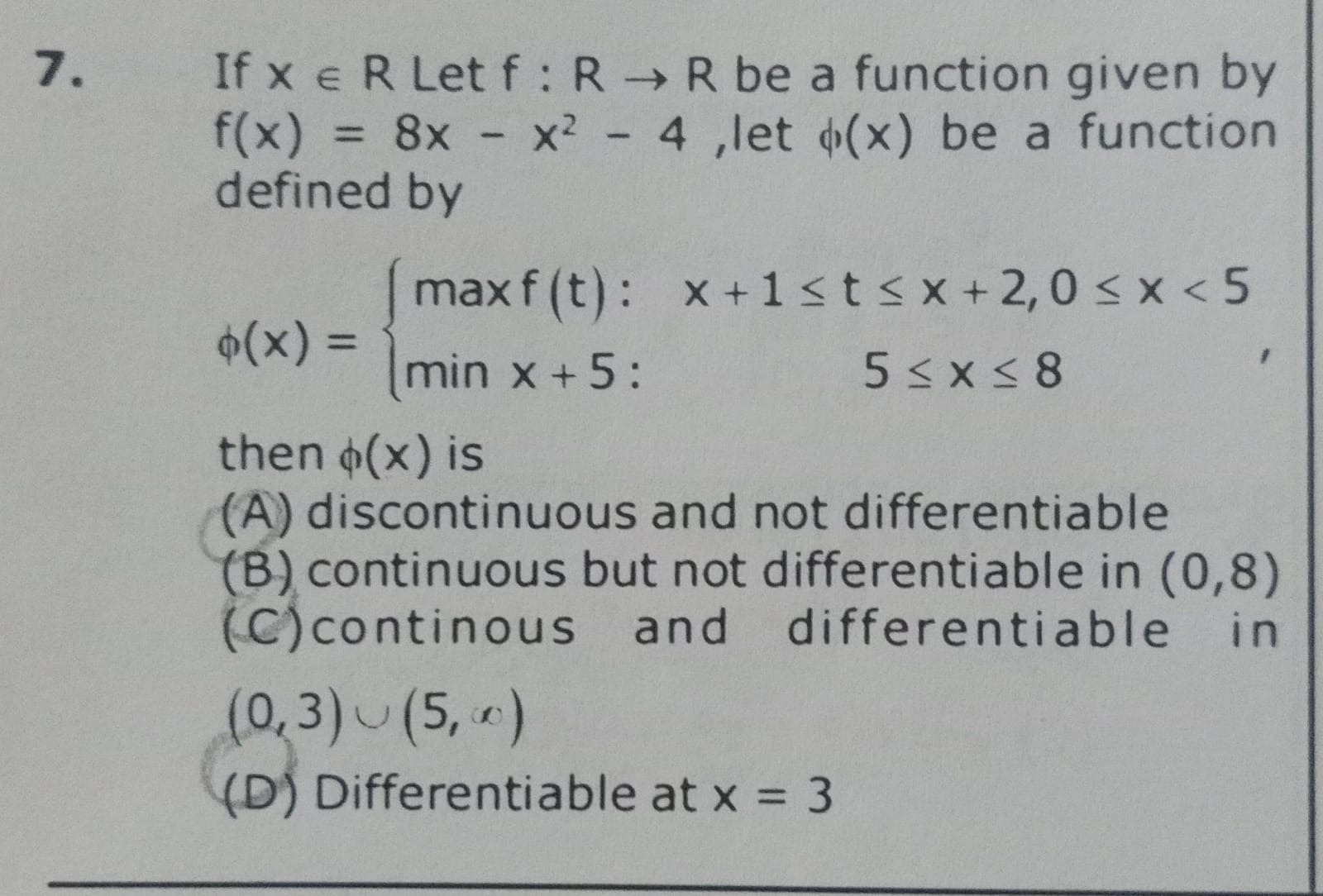Question
Question: If x ∈ R Let f: R→R be a function given by f(x) = 8x - x² - 4 ,let $\phi$(x) be a function defined b...
If x ∈ R Let f: R→R be a function given by f(x) = 8x - x² - 4 ,let ϕ(x) be a function defined by
ϕ(x) = {maxf(t):x+1≤t≤x+2,0≤x<5minx+5:5≤x≤8,
then ϕ(x) is

discontinuous and not differentiable
continuous but not differentiable in (0,8)
continous and differentiable in (0,3) ∪ (5,∞)
Differentiable at x = 3
discontinuous and not differentiable
Solution
The function f(t)=8t−t2−4=−(t2−8t+4)=−(t−4)2+12. This is a downward-opening parabola with vertex at t=4.
For 0≤x<5, ϕ(x)=maxt∈[x+1,x+2]f(t). The maximum of f(t) on [x+1,x+2] occurs at the vertex t=4 if x+1≤4≤x+2 (i.e., 2≤x≤3). In this case, ϕ(x)=f(4)=12. If x+2≤4 (i.e., x≤2), the interval is to the left of the vertex, and f(t) is increasing. The maximum occurs at t=x+2. For 0≤x≤2, ϕ(x)=f(x+2)=8(x+2)−(x+2)2−4=8x+16−(x2+4x+4)−4=−x2+4x+8. If x+1≥4 (i.e., x≥3), the interval is to the right of the vertex, and f(t) is decreasing. The maximum occurs at t=x+1. For 3≤x<5, ϕ(x)=f(x+1)=8(x+1)−(x+1)2−4=8x+8−(x2+2x+1)−4=−x2+6x+3.
For 5≤x≤8, ϕ(x)=min{x+5}. Assuming this means ϕ(x)=x+5 for 5≤x≤8.
So, the function is ϕ(x)=⎩⎨⎧−x2+4x+812−x2+6x+3x+50≤x≤22≤x≤33≤x<55≤x≤8
Let's check continuity at the transition points x=2,3,5. At x=2: limx→2−ϕ(x)=limx→2−(−x2+4x+8)=−(2)2+4(2)+8=−4+8+8=12. limx→2+ϕ(x)=limx→2+12=12. ϕ(2)=−(2)2+4(2)+8=12. Since the limits and function value are equal, ϕ(x) is continuous at x=2.
At x=3: limx→3−ϕ(x)=limx→3−12=12. limx→3+ϕ(x)=limx→3+(−x2+6x+3)=−(3)2+6(3)+3=−9+18+3=12. ϕ(3)=12. Since the limits and function value are equal, ϕ(x) is continuous at x=3.
At x=5: limx→5−ϕ(x)=limx→5−(−x2+6x+3)=−(5)2+6(5)+3=−25+30+3=8. limx→5+ϕ(x)=limx→5+(x+5)=5+5=10. ϕ(5)=5+5=10. Since the left and right limits are not equal, ϕ(x) is discontinuous at x=5.
Since ϕ(x) is discontinuous at x=5, it is not differentiable at x=5. Thus, ϕ(x) is discontinuous in the interval (0,8). Specifically, it is discontinuous at x=5.
Let's check differentiability in (0,8). For 0<x<2, ϕ′(x)=dxd(−x2+4x+8)=−2x+4. For 2<x<3, ϕ′(x)=dxd(12)=0. For 3<x<5, ϕ′(x)=dxd(−x2+6x+3)=−2x+6. For 5<x<8, ϕ′(x)=dxd(x+5)=1.
At x=2: Left derivative: limx→2−ϕ′(x)=limx→2−(−2x+4)=−2(2)+4=0. Right derivative: limx→2+ϕ′(x)=limx→2+0=0. Since the left and right derivatives are equal, ϕ(x) is differentiable at x=2 and ϕ′(2)=0.
At x=3: Left derivative: limx→3−ϕ′(x)=limx→3−0=0. Right derivative: limx→3+ϕ′(x)=limx→3+(−2x+6)=−2(3)+6=0. Since the left and right derivatives are equal, ϕ(x) is differentiable at x=3 and ϕ′(3)=0.
At x=5: Since ϕ(x) is discontinuous at x=5, it is not differentiable at x=5.
So, ϕ(x) is continuous in (0,5)∪(5,8) and differentiable in (0,2)∪(2,3)∪(3,5)∪(5,8). We found differentiability at x=2 and x=3. So, ϕ(x) is differentiable in (0,5). However, ϕ(x) is discontinuous at x=5, so it is not differentiable at x=5. Therefore, ϕ(x) is discontinuous and not differentiable in (0,8).
